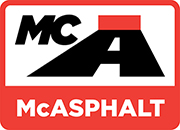Chip Seals
A chip seal, commonly referred to as a seal coat, is primarily made up of one size of aggregate that can be either washed or dusty. The aggregates can range in size from 19 mm to 4.75 mm. Generally, the largest particle should be no more than twice the diameter of the smallest one. Aggregate gradation and type dictate application rates for the aggregate and emulsions, as well as the type of emulsion.
Design Criteria
When designing a chip seal a number of factors have to be examined and assessed to ensure a proper surface will be placed that will perform for its service life. The following factors can have a tremendous effect on the performance of a chip seal; traffic, aggregate shape, specific gravity of the aggregate, aggregate wastage, residual asphalt content and the surface texture of the existing surface. If these factors are addressed the chances of a good chip seal being placed are greatly increased.
Traffic:
The type and quantity of traffic will have a large effect on the amount of asphalt emulsion to be used as well as the emulsion type. A rough rule of thumb is that as the traffic volume decreases from more than 2000 to less than 100 vehicles per day the quantity of emulsion increases 40 percent. If the amount of heavy truck traffic goes up then the quantity of emulsion used goes down.
Aggregate Shape:
The overall shape of the cover aggregate can influence the quantity of aggregate as well as the amount of asphalt emulsion. The more cubical (higher average least dimension (ALD)) the aggregate the higher the emulsion quantity needed. The measuring the voids space in the loose aggregate condition aids in determining the proper emulsion content as well as aggregate quantity.
Specific Gravity of Cover Aggregate:
The bulk specific gravity of the cover aggregate will affect the quantity of aggregate needed. The higher the specific gravity the more aggregate is needed and vice versa.
Aggregate Wastage:
In all chip seals an excess of cover aggregate has to be applied to offset the unevenness of spread and whip-off by traffic. Depending on the chip spreader equipment the excess amount can vary from 2 to 10 percent but is typically 5 percent.
Asphalt Residual in the Emulsion:
The quantity of asphalt residual in the emulsion can affect the quantity of emulsion needed to hold the cover aggregate. The lower the residual the higher the quantity of asphalt emulsion needed.
Surface Texture of Existing Pavement:
The texture of the existing road surface can influence the quantity of asphalt emulsion needed. If the surface is rich in texture indicating flushing or bleeding then a lower quantity of emulsion would be needed. If the texture is dry and oxidized then a higher quantity would be needed. Also if there a steep hills or curves then adjustments may have to be made to the quantity of emulsion used in those areas especially if there is significant truck traffic. Also the types of industry that are located on the road to be treated should be observed and what type of traffic could expected.
If these factors are taken into consideration in designing the chip seal then the chances of a successful seal are greatly improved.
Materials – Recycling Additives
Asphalt Emulsions:
A number of different types and grades of asphalt emulsions can be used in chip seals. The proper emulsion to be used is based on a number of factors; environmental conditions (temperature and humidity), traffic volume and type, type of cover aggregate and the existing road surface conditions (slope, shade, hills and curves). All these conditions affect the emulsion to be used. Typically the most common emulsions used are CRS-2, CRS-2P, RS-2, RS-2P, HP200, and HP200P.
Cover Aggregate:
The type of cover aggregate used in chip seals must meet certain requirements of shape, size, cleanliness and surface properties. The aggregate should be single sized and cubical in shape. The number of flat and elongated particles should be kept to a minimum so that the proper quantity of asphalt emulsion can be applied to hold the stone in place. The aggregate should be as clean as possible so that there is a good adhesive bond between the aggregate and the asphalt residue. Also the asphalt emulsion to be used and the aggregate must be compatible to ensure the asphalt-aggregate bond is effective.
Performance Guidelines
In order to construct a proper well designed chip seal the following guidelines should be followed:
- Assure the existing pavement structure is adequate to support expected traffic
- Design a chip seal with aggregate to be used on job
- Use clean dust free aggregate
- Calibrate and inspect all equipment
- Use sufficient number and properly weighted rollers
- Follow proper construction techniques
- Use traffic control to protect seal
- Work only in weather suitable for type and grade of emulsion being used
